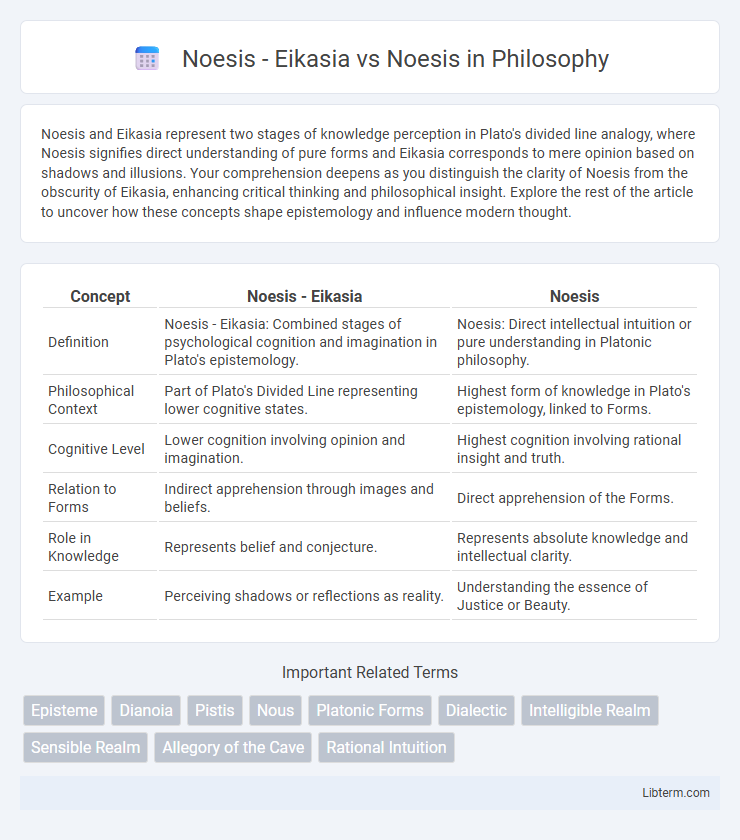Noesis and Eikasia represent two stages of knowledge perception in Plato's divided line analogy, where Noesis signifies direct understanding of pure forms and Eikasia corresponds to mere opinion based on shadows and illusions. Your comprehension deepens as you distinguish the clarity of Noesis from the obscurity of Eikasia, enhancing critical thinking and philosophical insight. Explore the rest of the article to uncover how these concepts shape epistemology and influence modern thought.
Table of Comparison
| Concept | Noesis - Eikasia | Noesis |
|---|---|---|
| Definition | Noesis - Eikasia: Combined stages of psychological cognition and imagination in Plato's epistemology. | Noesis: Direct intellectual intuition or pure understanding in Platonic philosophy. |
| Philosophical Context | Part of Plato's Divided Line representing lower cognitive states. | Highest form of knowledge in Plato's epistemology, linked to Forms. |
| Cognitive Level | Lower cognition involving opinion and imagination. | Highest cognition involving rational insight and truth. |
| Relation to Forms | Indirect apprehension through images and beliefs. | Direct apprehension of the Forms. |
| Role in Knowledge | Represents belief and conjecture. | Represents absolute knowledge and intellectual clarity. |
| Example | Perceiving shadows or reflections as reality. | Understanding the essence of Justice or Beauty. |
Introduction to Noesis and Eikasia
Noesis, derived from ancient Greek philosophy, denotes intellectual understanding or direct cognition, often linked to the highest form of knowledge. Eikasia represents the lowest level of cognitive awareness, characterized by perception based on shadows and reflections, corresponding to illusion or conjecture. The contrast between Noesis and Eikasia highlights the philosophical journey from ignorance and opinion to true knowledge and intellectual insight.
Philosophical Roots: Plato’s Theory of Knowledge
Plato's Theory of Knowledge distinguishes Noesis as the highest form of intellectual insight, representing pure, unmediated understanding of the Forms, while Eikasia is the lowest level of cognition, associated with illusion and imagination based on sensory perception. Noesis involves direct apprehension of eternal truths through dialectical reasoning, foundational to Platonic epistemology in the Republic and the divided line analogy. This dichotomy underscores Plato's emphasis on rational knowledge over empirical evidence, shaping classical interpretations of knowledge and reality.
Defining Noesis: The Intellect’s Highest Form
Noesis, as the intellect's highest form, represents direct, intuitive understanding or pure intellectual insight, surpassing mere sensory perception or discursive reasoning. In contrast, Eikasia involves imagination and conjecture, relying on images rather than true knowledge, thus positioning Noesis as the essential faculty for grasping the Forms or ultimate realities in Platonic philosophy. Defining Noesis highlights its role as the pinnacle of cognitive activity, where the mind apprehends truths through immediate intellectual apprehension, forming the foundation for genuine knowledge and wisdom.
Exploring Eikasia: The Realm of Images and Illusions
Eikasia, within Plato's divided line, represents the lowest level of knowledge characterized by perception of shadows and reflections, symbolizing illusions and images rather than true forms. This realm contrasts with Noesis, the highest intellectual state involving direct apprehension of pure, unchanging Forms through rational insight. Exploring Eikasia reveals how human understanding often begins with deceptive sensory experiences before ascending toward genuine knowledge.
Noesis vs Eikasia: Key Differences
Noesis refers to direct intellectual cognition or understanding, whereas Eikasia represents imagination or perception based on shadows and appearances in Platonic philosophy. The key difference lies in Noesis involving true knowledge and reasoned insight, while Eikasia pertains to mere belief or illusion without certainty. Noesis engages with abstract forms and reality, in contrast to Eikasia's focus on sensory representations and deceptive images.
The Role of Noesis in True Understanding
Noesis represents the direct intellectual intuition of truth, enabling immediate and clear comprehension beyond sensory experience or mere opinion. In contrast to Eikasia, which involves imagination and shadowy perceptions, Noesis facilitates true understanding by grasping the Forms or essences of reality through rational insight. The role of Noesis is central in philosophy as it allows the intellect to transcend appearances and access absolute knowledge.
The Limitations of Eikasia in Human Cognition
Eikasia represents the lowest level of human cognition, characterized by imagination and shadow perception rather than direct knowledge. This limitation confines individuals to mere appearances, preventing access to true forms or reality, which Noesis seeks through intellectual understanding and reasoning. The transition from Eikasia to Noesis marks overcoming cognitive illusions, enabling deeper insight and authentic knowledge acquisition.
Noesis in Modern Epistemology
Noesis in modern epistemology refers to the act of intellectual intuition or direct cognition, contrasting with noesis-eikasia which encompasses a broader spectrum of mental representations including images and opinions. Philosophers emphasize noesis as the pure act of knowing, distinct from sensory experience and mere belief, shaping contemporary discussions on the nature of knowledge and consciousness. This concept underpins analyses of how humans achieve true understanding beyond perceptual data, influencing theories in phenomenology and analytic philosophy.
Practical Implications: Noesis and Eikasia in Everyday Life
Noesis involves direct intellectual apprehension of truth, enabling clear decision-making and problem-solving in daily activities, while Eikasia represents mere opinion or illusion, often leading to misconceptions and errors. In practical terms, Noesis supports critical thinking and informed judgments, essential for effective communication and responsible action. Recognizing the difference enhances personal growth by fostering a mindset grounded in reality rather than assumption or false belief.
Conclusion: Elevating from Eikasia to Noesis
Elevating from Eikasia to Noesis signifies a profound cognitive shift from mere imagination or perception to true intellectual understanding and knowledge. This transition reflects Plato's epistemological hierarchy, where Noesis represents the highest form of rational insight, transcending the illusions of Eikasia. Embracing Noesis fosters clarity, wisdom, and an authentic grasp of Forms, enabling individuals to access ultimate truths beyond sensory deception.
Noesis - Eikasia Infographic

 libterm.com
libterm.com